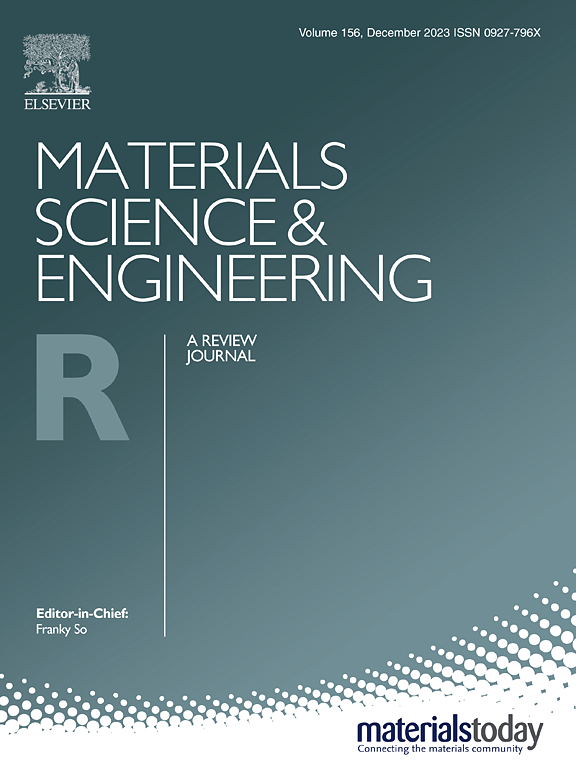二维材料的压电学和摩擦学
IF 31.6
1区 材料科学
Q1 MATERIALS SCIENCE, MULTIDISCIPLINARY
引用次数: 0
摘要
二维(2D)材料具有优异的电子/热/机械性能,为促进各种复杂电子产品的快速发展提供了材料科学的范式转变。结合二维材料,新兴的压电和摩擦电子学可以进一步利用外部机械刺激以主动和直接的方式调节其传输特性,在后摩尔时代提供更多样化和多用途的可能性。本文从压电电子学和二维材料摩擦电子学的起源和发展入手,综述了它们的工作原理、二维材料中的压电电子学、压电纳米发生器(PENG)/摩擦纳米发生器(TENG)调制二维场效应晶体管(fet)的研究进展及其广泛应用。首先,本文重点介绍了非中心对称压电材料和界面工程,以赋予二维材料压电性能,并讨论了各种结构设计及其在环境/机械传感中的应用。其次,讨论了PENG/TENG调制二维场效应管在机械传感、带结构工程、人工突触等方面的应用。最后,从结构设计和功能方面总结了二维材料的压电学和摩擦学在材料到器件层面的优势。并指出了器件的制备和加工、可靠性和稳定性等方面存在的挑战。二维材料与压电/摩擦学的协同集成有望成为当前信息技术的重要补充,超越摩尔定律,在自供电智能设备/系统,自适应人机交互,边缘智能人工假体等方面呈现出巨大的前景。本文章由计算机程序翻译,如有差异,请以英文原文为准。
Piezotronics and Tribotronics of 2D Materials
Two-dimensional (2D) materials, featuring superior electronic/thermal/mechanical properties, offer a paradigm shift in material science for boosting the rapid development of various sophisticated electronics. Combining with 2D materials, emerging piezotronics and tribotronics can further utilize external mechanical stimuli to modulate their transport properties in an active and direct fashion, delivering more diverse and versatile possibilities in the post-Moore era. Starting with the origin and development of piezotronics and tribotronics with 2D materials, this review provides a comprehensive investigation of their working mechanism, piezotronics in 2D materials, and research progress on piezoelectric nanogenerator (PENG)/triboelectric nanogenerator (TENG) modulated 2D field-effect transistors (FETs) and their broad applications. First, this review focuses on non-centrosymmetric piezoelectric materials and interface engineering to endow 2D materials with piezoelectric properties, and discusses diverse structural designs and applications in environmental/mechanical sensing. Second, the applications of PENG/TENG modulated 2D FETs are discussed regarding mechanical sensing, band structure engineering, artificial synapses, and so on. Finally, the advantages of piezotronics and tribotronics of 2D materials from material to device level are summarized in terms of structural design and functionality. Challenges related to the preparation and processing, reliability and stability of the devices are also pointed out. Synergistic integration of 2D materials with piezo/tribotronics is expected to be a significant complement to current information technology to go beyond Moore's Law, presenting great promise in self-powered smart devices/systems, adaptive human-robot interaction, edge-intelligent artificial prosthesis, etc.
求助全文
通过发布文献求助,成功后即可免费获取论文全文。
去求助
来源期刊

Materials Science and Engineering: R: Reports
工程技术-材料科学:综合
CiteScore
60.50
自引率
0.30%
发文量
19
审稿时长
34 days
期刊介绍:
Materials Science & Engineering R: Reports is a journal that covers a wide range of topics in the field of materials science and engineering. It publishes both experimental and theoretical research papers, providing background information and critical assessments on various topics. The journal aims to publish high-quality and novel research papers and reviews.
The subject areas covered by the journal include Materials Science (General), Electronic Materials, Optical Materials, and Magnetic Materials. In addition to regular issues, the journal also publishes special issues on key themes in the field of materials science, including Energy Materials, Materials for Health, Materials Discovery, Innovation for High Value Manufacturing, and Sustainable Materials development.
 求助内容:
求助内容: 应助结果提醒方式:
应助结果提醒方式:


